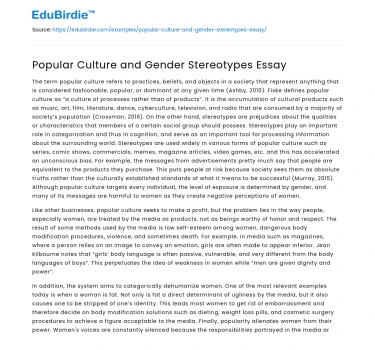The term popular culture refers to practices, beliefs, and objects in a society that represent anything that is considered fashionable, popular, or dominant at any given time (Ashby, 2010). Fiske defines popular culture as “a culture of processes rather than of products”. It is the accumulation of cultural products such as music, art, film, literature, dance, cyberculture, television, and radio that are consumed by a majority of society’s population (Crossman, 2016). On the other hand, stereotypes are prejudices about the qualities or characteristics that members of a certain social group should possess. Stereotypes play an important role in categorization and thus in cognition, and serve as an important tool for processing information about the surrounding world. Stereotypes are used widely in various forms of popular culture such as series, comic shows, commercials, memes, magazine articles, video games, etc. and this has accelerated an unconscious bias. For example, the messages from advertisements pretty much say that people are equivalent to the products they purchase. This puts people at risk because society sees them as absolute truths rather than the culturally established standards of what it means to be successful (Murray, 2015). Although popular culture targets every individual, the level of exposure is determined by gender, and many of its messages are harmful to women as they create negative perceptions of women.
Like other businesses, popular culture seeks to make a profit, but the problem lies in the way people, especially women, are treated by the media as products, not as beings worthy of honor and respect. The result of some methods used by the media is low self-esteem among women, dangerous body modification procedures, violence, and sometimes death. For example, in media such as magazines, where a person relies on an image to convey an emotion, girls are often made to appear inferior. Jean Kilbourne notes that “girls’ body language is often passive, vulnerable, and very different from the body languages of boys”. This perpetuates the idea of weakness in women while “men are given dignity and power”.
Save your time!
We can take care of your essay
- Proper editing and formatting
- Free revision, title page, and bibliography
- Flexible prices and money-back guarantee
In addition, the system aims to categorically dehumanize women. One of the most relevant examples today is when a woman is fat. Not only is fat a direct determinant of ugliness by the media, but it also causes one to be stripped of one’s identity. This leads most women to get rid of embarrassment and therefore decide on body modification solutions such as dieting, weight loss pills, and cosmetic surgery procedures to achieve a figure acceptable to the media. Finally, popularity alienates women from their power. Women's voices are constantly silenced because the responsibilities portrayed in the media are not worth the dignity of a voice.






 Stuck on your essay?
Stuck on your essay?

